
by Lori Vande Krol | Jun 22, 2022 | General Productivity, Goals and Priorities, Motivation, Procrastination, Team Productivity, Time Management
I have a confession to make. Months went by this year before I finally took focused time to set my annual goals. While I help others to do this daily and understand the importance and benefit of annual goal setting, I was not able to complete the task for myself. I took some time to reflect on my reasons for procrastinating on this task, which helped me to work through and complete the process. Following are a few reasons you might find goal setting difficult as well as some tips and resources to make it simpler.
1. The goal, outcome, or supporting actions, are unclear.
Too many times, I have gotten hung up on taking action because the end result, or the full range of steps I need to take to get there, is not completely clear. I have to remind myself that taking some action is better than nothing at all. Often, as you start to take action the goal and end result becomes clearer.
In his article, The Goal is Not the Point, James Clear says: ” In other words, your goal becomes your compass, not your buried treasure. The goal is your direction, not your destination. The goal is a mission that you are on, a path that you follow. Whatever comes from that path—whatever treasure you happen to find along this journey—well, that’s just fine. It is the commitment to walking the path that matters.”
When the goal or destination is not clear, consider your goal a direction you are heading, and clarify the end result as you go.
2. Setting big goals is scary.
There are many fears that can hold us back from setting and achieving goals. “What if I fail?” or “What if I succeed? Can I handle it? What comes next?” Perhaps it is a fear of change or a fear of losing control that is holding you back. In times like this, you must ask yourself, “What happens if I don’t try?”
Are you willing to live with more of the same? The status quo? Or are you willing to accept some risks and potential challenges in order to grow and achieve more? What great things might happen, for yourself and others, if you succeed? Take time to evaluate your fears. Learn what is driving the fear and anxiety in order to push forward. You may find that you even enjoy the journey.
3. Goal setting has not been successful in the past.
Last fall I was presenting a course on procrastination. When discussing potential reasons for procrastination, I shared that we often fail to take action when the end goal is unclear. An attendee raised her hand and asked, “What is the point of setting goals? It never works.” I challenged her to think more deeply about her hesitation toward goalsetting. I asked if there was possibly something else holding her back. After the presentation, we talked further, and I learned that she had worked for large corporations most of her career. Those companies would go through the annual goalsetting process, but it would end there. Management would not follow through or follow up on the actions required to achieve those goals. Goals were not reviewed regularly. Employees were also unclear on how the company’s goals tied to their own vision and goals. The lack of a full system for goal setting and implementation caused it to fail, and employees no longer trusted the process.
If goal setting has not been successful for you in the past, reflect on the true reasons for this. What can be done differently to improve your chances of success? There are many tools and tips to support individual, team, and company goalsetting. The systems and processes used need to work for everyone involved. Below I share additional resources for successful goalsetting.
The potential reasons for avoiding the task of goal setting are not unlike the reasons for procrastinating any task. The first step is working to understand your unique reasons for avoidance and then to find the right tool and process for you and/or your team. There is no doubt you will grow and achieve more.
Additional Resources for Goal Setting
Goal Setting: A Scientific Guide to Setting and Achieving Goals by James Clear
Mastering Time Management: What To Do Before the To-Do List by Lori Vande Krol
Do You Have a Lot of Big Goals? Focus on What You Know and Love by Lori Vande Krol
The Superman: Goal Achieved by Lori Vande Krol
The ProAction Planner™: a system to turn your annual goals into action throughout the year
FREE DOWNLOAD: Use the button below to receive a free Annual Goal Setting Template
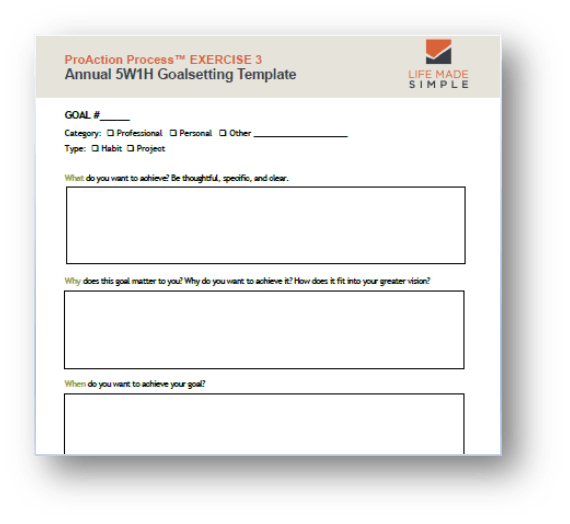
Annual 5W1H Goalsetting Template
FREE DOWNLOAD
It is not too late to set your annual goals for this year! If you’d like assistance with the goal-setting process, or in setting up systems for success, contact Lori at Life Made Simple or schedule your free 30-minute consultation. I’d love to help!

by Lori Vande Krol | Jan 14, 2021 | Goals and Priorities, Habits, Motivation, Task and Project Management, Time Management
If you are like most creative, driven entrepreneurs and professionals, you have a lot of big goals, fun projects, and life-changing ideas on your plate – not to mention the other day-to-day tasks and activities that take up your time. Without a good process for analyzing, prioritizing, and planning, you can become overwhelmed and frustrated that yet another day – or week – goes by without measurable progress. Here I share 3 ways to address this overwhelm so you can reach your big goals quickly and with more focus and less stress, allowing you to share your passions with the world and have fun at the same time.
Success = Skill + Passion + Hard Work
Paul Torrance, Distinguished Professor, researcher, and developer of the Torrance Tests of Creative Thinking, conducted a 40-year longitudinal study of creative individuals. Based on the results of his study, Torrance developed the Manifesto for Children to guide them as they grow and struggle to maintain their creativity and use their strengths to create careers. While Torrance intended his manifesto for children, I think the guidance applies to adults as well.
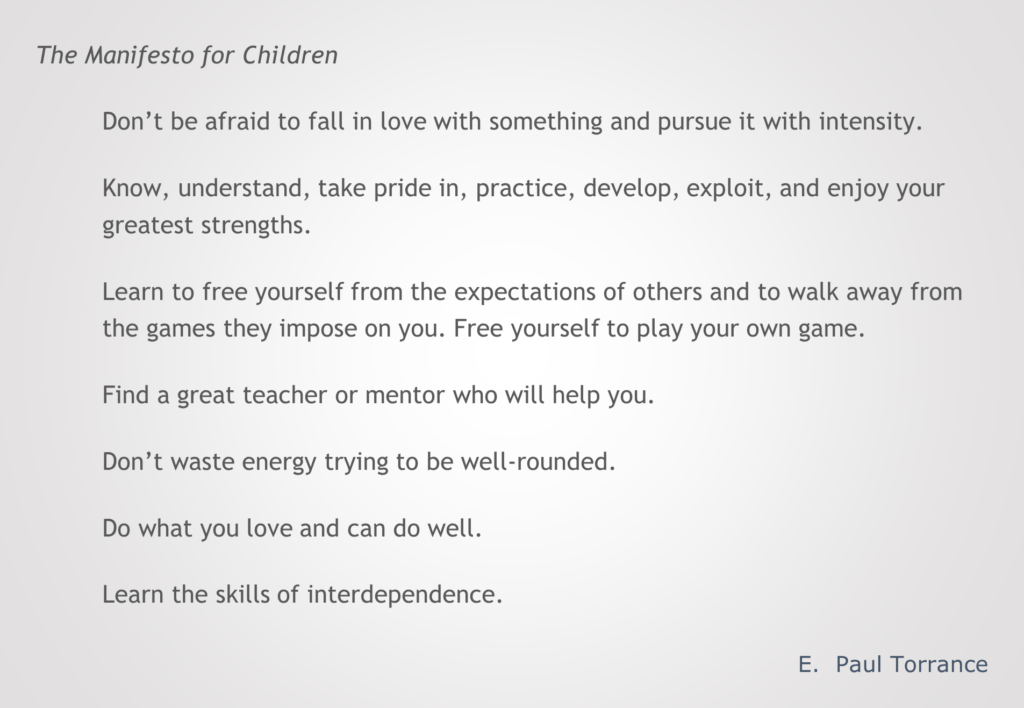
Many of us learn these important ideas later in life, or maybe not at all. Torrance hoped to help improve a creative individuals’ chance of success and life fulfillment with his study and manifesto.
Similarly, you will be most successful and be able to help others more when you focus your time and energy on those things you are good at and passionate about. Big goals take hard work and if you don’t have the knowledge and excitement, you will be much less likely to put in the time and effort required. To narrow down the activities you should be spending your time on, draw the following grid on a piece of paper, and divide your ideas, goals, and activities into these categories:
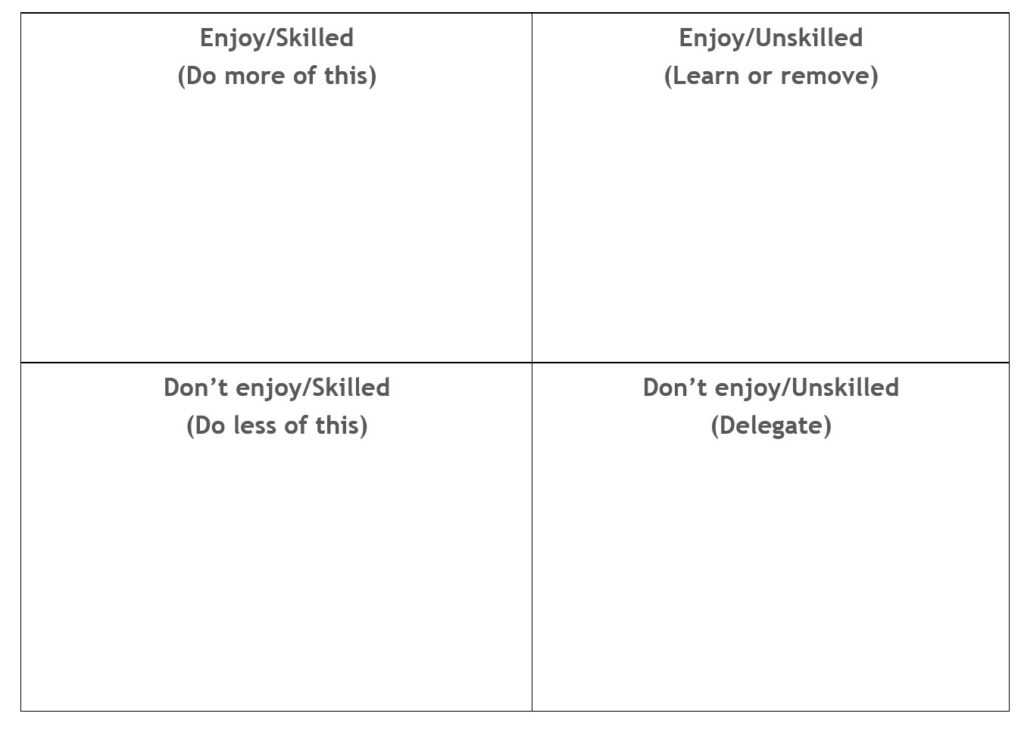
You will want to spend the most time on activities and goals from the top-left “Enjoy/Skilled” quadrant and develop educational or learning goals from the top-right “Enjoy/Unskilled” quadrant. Or, if these activities don’t serve your greater goals, consider removing them. Look at delegating tasks in the bottom half of the grid – those you don’t enjoy – or if possible, remove them. Deleting tasks that don’t serve your greater purpose and goals will open the door for new opportunities.
Determine What To Start, Stop, or Continue Doing
A second exercise that can help you focus on your passions and priorities is the “Start/Stop/Continue” exercise. Write these three words on the top of a piece of paper and list all of those things you would like to start doing, stop doing, and continue doing. If you are a visual person, you might use mind-mapping as a way to brainstorm activities or tasks for each category.
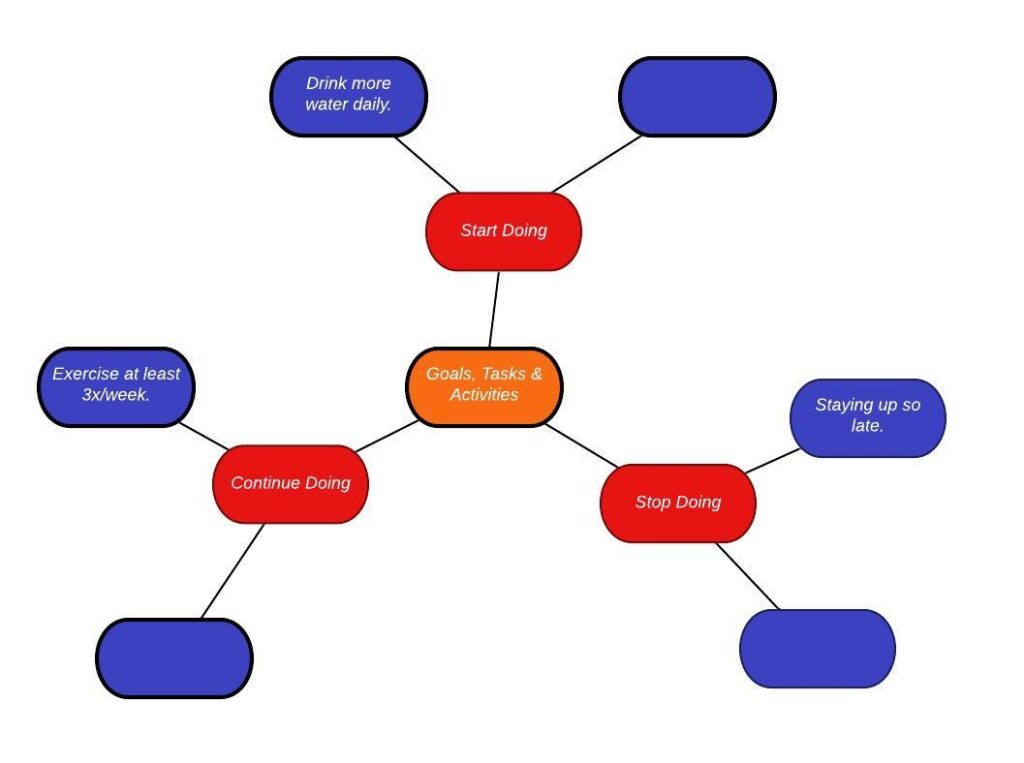
Be realistic when considering your time and energy over the time period considered. This is a great exercise for habit-related activities and goals. For example, in order to have the energy and focus for my big goals, I would like to start drinking more water daily, stop staying up so late, and continue exercising at least 3 days per week.
Find Support and Accountability to Reach Your Goals
Being an entrepreneur, business owner, or leader can be lonely. You want to do great things but may not have someone that understands and shares your passion and drive. Without someone there to communicate your struggles and help get through roadblocks, there may be a loss of momentum or halted progress on your goals. It’s also important to be able to share your excitement when reaching milestones. E. Paul Torrance felt strongly enough about this to include two related items in his Manifesto for Children: “Find a great teacher or mentor who will help you.” and “Learn the skills of interdependence.”
Following are a few different ways you can find this support and assistance:
- An accountability partner. This may be a family member, friend, or colleague, as long as they share your drive and passion and provide the support and encouragement you need through the good and challenging times.
- A mastermind group. The advantage of a formal mastermind group is you have a team of people with different backgrounds, experiences, and skillsets as you work to set and reach your goals. For the best chance of success, I would recommend a paid group with an experienced leader/host.
- A business, life, or productivity coach. Sometimes it makes the most sense to hire a coach to help you get clear on your passions, strengths, and goals and then to help you develop the plan to reach those goals. This person should provide motivation and accountability, be a sounding board as you work through challenges and offer solutions to keep you moving, and be your greatest cheerleader when things go well.
The world needs your big ideas – your book, your product, your new business, your knowledge, your energy, your talent. What will you do to ensure you prioritize, focus, and take action so you can reach your biggest goals?
More blogs related to Priorities, Goal-Setting, and Planning:
Get Unstuck with a Simple Project Plan
Create Your Top 10, and Bottom 10, List
The Superman: Goal Achieved

by Lori Vande Krol | Sep 3, 2020 | Goals and Priorities, Habits, Motivation, Procrastination
I have something to confess – I have been a pretty bad cook most of my life. I don’t enjoy it and although I knew my family could be eating healthier, better-cooked meals, I’ve never really had an interest in learning – until recently. For a few reasons I’ll get into later, I decided I would challenge myself to learn how to feed my family in a “cleaner” way. Questions that crossed my mind were: “Where do I start? Do I have the right equipment and tools? Where do I get my groceries? How do I know what “eating clean” means? Will the family like the meals? How much time will it take? Will it even help? How can I change habits after so many years of doing it a different way?” There were a lot of unknowns for me and it was a little scary getting started.
Below I share my process and how you can use this same process to change any habit. It’s never too late to learn and grow!
Know Your “Why” for a Habit Change
Sometimes the most difficult step in changing a habit is deciding to do so. In her book Better Than Before, Gretchen Rubin states “A habit requires no decision from me, because I’ve already decided” (Rubin, 2015, p. 5). But even if you have made the tough decision to work on a habit, change is hard. It’s easy to quit. Things often get harder before they get easier. That is why it is important to be clear about your “why” for learning something new or changing a habit. Your “why” needs to be important enough to drive you to start and to continue when things get rough, which I guarantee they will.
Recently in my work with a client, she shared how she had been struggling with changes in daily working habits. Some days were so mentally draining she would have to take a nap to keep going. We reviewed her “why” and decided she would post a photo or vision board near her desk that reminded her of it daily. Doing this helped her to make better choices, focus her work, and maintain energy to reach her goals.
I have several “whys” for changing the way that I shop, cook, and eat, a few of which include increased food sensitivities in the family, a need to eat well to support exercise and sports, setting a good example for my children to be as healthy as possible, and to challenge myself to learn something new during some Covid-19 related downtime. I was also motivated by the short time I had to put new habits in place before the inevitable craziness that comes with back-to-school activities. All of these “whys” were strong enough priorities to spur me into action and to keep me going on the toughest days.
Research and Find the Best Tools to Support Your Habit
Before choosing the right tools to support your habit, it’s important to be clear on your vision for success and what is needed to help you get there. Will your new habit require enhancements to your current tools and systems or the need for something new? For example, if you are wanting to exercise at home regularly, what type of exercise will help you reach your goals? Do you have the right equipment available?
Or maybe you have decided to create a better habit of planning and scheduling your week. Do you prefer doing so in a paper or digital format? What features does your tool or process need to offer the best chance at success? It is important to analyze your needs and preferences before deciding on the tools that will best support your new habit.
I knew I didn’t have the systems, tools, or knowledge to change our cooking and eating habits on my own. If I was going to be successful, I needed to research and educate myself. I started by Googling “clean eating for families” and reached out to an exercise group I belong to. My research led me to Momables.com and the 30-Day Family KickStart program, which is a 4-week sugar-free, gluten-free, and dairy-free (optional) clean eating program. Momables provided me with weekly menus, shopping lists, and preparation tips. In addition, the program suggested equipment and tools that would support my new habit as well as general education about clean eating.
Find Support and Accountability to Reach your Goals
Creating new habits can be lonely without the right people to support and provide you with accountability and motivation. I found this in a few ways:
 (1) I ensured my family was on board with the new eating plan. If I didn’t have their support, it would not have worked.
(1) I ensured my family was on board with the new eating plan. If I didn’t have their support, it would not have worked.
(2) The creator of Momables, Laura Fuentes, reached out to let me know she was available for any support needed. Her regular email communications also kept me on track and motivated me to continue.
(3) The exercise group I belong to often discusses the need for clean eating to support any training or workouts. Hearing others’ challenges and successes provided motivation when things were hard.
Who can provide you with the support, motivation, knowledge, and accountability you need to succeed in your journey to learn, grow, and develop new habits?
Celebrate and Maintain Your Success
Once you have reached your goal, it is important to recognize it. Celebrate your accomplishment, and then determine how you will maintain your success. My family and I planned two celebrations during our 4-week challenge – after two weeks, we enjoyed s’mores by the fire as a “cheat” night. After we completed the full plan, we celebrated with a trip to the local ice cream shop. Knowing we had these milestones scheduled – that we would be able to enjoy a sugary treat soon – helped to keep us on track the rest of the time.
 Now that we have completed the 4-week kickstart program, we have set a goal to maintain an “80%” clean-eating habit. With the help of a weekly dinner plan from Momables, I now have the knowledge, tools, and resources to continue this new lifestyle. We know we won’t be perfect and I would be crazy to think we are “cured” from sugary foods for good, but we have created healthier habits that we will be able to maintain going forward.
Now that we have completed the 4-week kickstart program, we have set a goal to maintain an “80%” clean-eating habit. With the help of a weekly dinner plan from Momables, I now have the knowledge, tools, and resources to continue this new lifestyle. We know we won’t be perfect and I would be crazy to think we are “cured” from sugary foods for good, but we have created healthier habits that we will be able to maintain going forward.
Depending on the habit or change you work to develop, you may not be perfect all of the time and that’s okay. What is important is that you have systems in place to maintain what you have started and can get back on track quickly and easily. Don’t be too hard on yourself and be sure to celebrate the wins.
A Process for Changing or Forming a Habit
After 20 years of the excuses “I hate to cook” or “I don’t know how to cook” as a reason for not learning how to do better, I am proof that it is never too late to learn and change. The techniques and knowledge I gained over those 4 weeks have provided me the basis I need to continue with better habits for myself and my family. Whatever it is you feel you could do better, decide to do it, and then follow this process for success:
- Know your “why”
- Research and find the best tools
- Find support and accountability
- Celebrate and maintain your success
Please share your goals and progress. And if you need assistance with the process, don’t hesitate to reach out for coaching support.
Learn more about Life Made Simple’s Productivity Coaching Plans.
Sources:
Rubin, Gretchen. Better Than Before. New York: Broadway Books, 2015. Print. p. 5.
Momables. www.Momables.com/. Accessed August 2020.

by Lori Vande Krol | May 21, 2020 | Motivation, Procrastination, Task and Project Management, Time Management
“I have so much to do and I just can’t make myself do anything.” This is what I heard from my teenage daughter last week when I walked into her bedroom. Emma is a junior in high school and was trying to juggle three college placement tests, preparation for two choir auditions, and homework for four classes, all on her own and online due to Covid-19. I immediately put on my “productivity consultant hat” and asked her, “Have you made a list? Did you schedule everything into your bullet journal? Are you focusing on what has to be done this week?” She continued, “I’ve done all the things, mom, but nothing is working.”
Do you ever feel overwhelmed by a lengthy to-do list, and all of it feels of equal importance? Sometimes we can feel so much anxiety by looking at our many to-do’s that we don’t know where to start, and the methods and habits that have worked in the past just aren’t working now. Below I share a couple of quick tips to help you get through the most overwhelming of times.
Choose One Thing to Focus on Right Now
Continuing with the example of my daughter’s stressful situation, I asked her, “Why don’t you choose three things to focus on and forget about the rest? Just work to check those off your list one by one to feel a sense of accomplishment.” I knew that once she got those first three things done, she would feel a little better about moving to the next on her list. After hearing that she had also tried this “trick” and it still didn’t kick-start her motivation, I left her with, “Okay, turn on your relaxing music, chose one thing to do right now, and then we will talk again.”
During the most stressful times, you may need to pare back to the most basic productivity strategy – choose just one thing to focus on right now. Ask yourself, “What is the next action I need to take to move a project or task forward?” Do that and then find the next thing to focus on. Soon you should start to feel a sense of control over your to-do’s, your stress levels will decrease, and you can work to get a better handle on the rest of your list.
Choose Three Things to Focus On Today
Later that morning, Emma explained that she had been thinking about the “choose three things” method and wondered if it hadn’t worked in the past because she didn’t write her goals down – instead, she had just determined in her head what three tasks she would do. I told her I would check in with her via text for the next few days to remind her to write down her three goals and check on her progress. Here was the first day’s response:
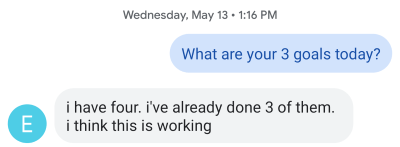
Success! At least for that day. This extra act of writing down her goals added to the intentionality of the actions and was just enough to get her over her productivity hurdle. The next day’s text was answered with a list of her three goals for that day. Emma may not continue this habit every day moving forward. Instead, she will likely go back to her normal method of weekly planning in her bullet journal. But it was what she needed to get through the high stress levels she was encountering at that time.
When to Use This Simple Process for Increased Productivity
As discussed, using the process of choosing three goals each day is a great tool during times of high stress or feelings of extreme overwhelm. This is also a great process to use if you haven’t yet developed a weekly and/or daily planning habit. Begin with a brain dump of all of your to do’s. Get them off your mind and on paper, or in digital form. Prioritize them if you can. Then, each morning choose three goals to focus on that day.
- Each morning, choose three things you will accomplish today.
- Write them down. Consider sharing them with someone.
- Get to work!
What’s Next?
Once you complete your three goals for the day, celebrate, and then choose the next 1-3 actions. Soon you will have more control and a better perspective of your to-do’s. When you are ready to move to the next level of weekly and daily planning, take a look at “What Should I Do Right Now?” for additional planning tips.
If you struggle with goal setting, prioritization, planning, or are just feeling overwhelmed with work and life, please reach out to me or schedule your free 30-minute Productivity Assessment. I would love to help you gain control and develop the habits that save you time, energy, and stress.

by Lori Vande Krol | Apr 23, 2020 | General Productivity, Motivation
One of the most controversial topics I’ve posted on social media has been whether or not it is important to make your bed every morning. I admit to not being a daily bed-maker (sorry Mom) and was excited to share this article by Tim Denning backing up my decision, albeit written more aggressively than I would have (e.g.“This is stupid advice. Don’t follow it.”) But I do appreciate the author’s point of view to focus on larger tasks first thing in the morning before you are worn out by the day’s events. Mr. Denning argues that making your bed won’t change the world, but other tasks can. My post was met with support by fellow “non-bedmakers” including successful leaders I think highly of. But I also heard from “daily bedmakers” I respect and admire, including my mother, who are passionate about their decision and reasons for making their beds daily.
During a 2014 commencement speech given at the University of Texas by Naval Admiral William H. McRaven, Admiral McRaven explained the importance of a perfectly made bed during basic SEAL training. He ended this section of his speech with, “If you want to change the world, start off by making your bed.” Honestly, who am I to argue with the former commander of the U.S. Special Operations?
How then, can these completely opposing views about the importance of this simple task in our daily lives both be right? Let’s dig a little deeper.
Why You Might Make Your Bed Every Day
An unofficial poll on one of my social media accounts gathered several comments as to why the “bed-makers” take the time each day:
- “Starting out the day with a simple completed task sets me up to do better during the day. If I don’t do that first task then pretty soon everything just feels overwhelming so why do anything.”
- “I think [not making your bed] sets up for a too relaxed way of living.”
- “I love the feeling of coming into my bedroom and having everything clean and nice looking. I feel like it helps my mind relax at night and feel less cluttered.”
- “It’s a simple thing I can do while my brain is still fuzzy (and not yet ready to tackle big things) and it sure feels good later in the day.”
- “The best part of making the bed is climbing into a nice crisp bed at night. I don’t want YESTERDAY covers!”
But what if this isn’t true for all of us? Let’s take a look at the other side of the story.
Why I Don’t Make My Bed
I was brought up to feel that making my bed was just part of the daily routine – you shower, get dressed, brush your teeth, and make your bed. So as a young adult, I continued to make my bed every day. But then I got married and my husband didn’t make the bed. When I asked if he would chip in every once in a while, he told me, “I don’t make the bed. My grandma taught me it needs to air out.” What? At the time, this sounded like an interesting made-up reason to not take responsibility, but I’ll get back to that. Without my spouse taking on his share of the task, I started to wonder how important it really was and soon began to periodically skip this daily activity.
Then I had children, started my business, and began working at home. I found that I could spend half of my day picking up and cleaning the house before I even “got to work.” I had to discipline myself to let some of it go, and bedmaking became one task I was okay giving up. Today, I make the bed fully only when someone is coming over, on cleaning days, and on rare days when “I just feel like it.” Most days, I just throw the comforter up over the pillows and call it good.
What I found over time is that it really didn’t matter. I could walk out of the bedroom and into my office and feel just as productive whether I made my bed or not. But recently, during the COVID-19 quarantine, I learned I have a different “productivity trigger” when working from home. I need to wear makeup. I learned this when my daughter walked into the bathroom while I was getting ready for the day and said, “Why are you putting makeup on?” I responded, “For you guys, I guess.” As I thought more about it, I realized my family doesn’t care if I wear makeup (they’ve seen me at my worst), but I do. Putting on just a minimal amount helps me to feel more awake and energized which leads to more productivity.
Obviously wearing makeup isn’t going to be the trick for everyone – we are all motivated and energized by different things. If you can’t jump immediately into a “change the world task” first thing in the morning, as Tim Denning suggests in his article, what small action can you take each day to increase your energy, motivation and productivity? Perhaps it is making your bed or putting a little makeup on. Or it may be something completely different such as a morning jog, journaling, or meditation.
Read The Following At Your Own Risk
A few years ago, I decided to look into my husband’s claim regarding beds needing to “air out” each day and guess what? There is actually some truth to it. You may regret reading what follows, so continue at your own risk. The article The Reason Scientists Say You Shouldn’t Make Your Bed cites research from a 2015 Kingston University study when it states “making your bed in the morning traps in dust mites that have accumulated overnight and provides a breeding ground for allergens that can exacerbate asthma and allergies.” I’ll spare you the more gruesome details (check out the article for this), but according to the Simplemost.com article, making your bed first thing in the morning traps in moisture, allowing your bed to be a home for up to 1.5 million dust mites. If you leave your bed messy, however, the mites are exposed to air and sunlight, which causes them to become dehydrated and die out. So for those that are not daily bed-makers, you may actually be healthier because of it.
What Works For You?
I’d love to hear what is or is not included in your morning routine that helps you have a more productive day. Has your time at home during COVID-19 changed your morning routines or habits? Share a comment below or reach out via email.









 Now that we have completed the 4-week kickstart program, we have set a goal to maintain an “80%” clean-eating habit. With the help of a weekly dinner plan from Momables, I now have the knowledge, tools, and resources to continue this new lifestyle. We know we won’t be perfect and I would be crazy to think we are “cured” from sugary foods for good, but we have created healthier habits that we will be able to maintain going forward.
Now that we have completed the 4-week kickstart program, we have set a goal to maintain an “80%” clean-eating habit. With the help of a weekly dinner plan from Momables, I now have the knowledge, tools, and resources to continue this new lifestyle. We know we won’t be perfect and I would be crazy to think we are “cured” from sugary foods for good, but we have created healthier habits that we will be able to maintain going forward.


Recent Comments